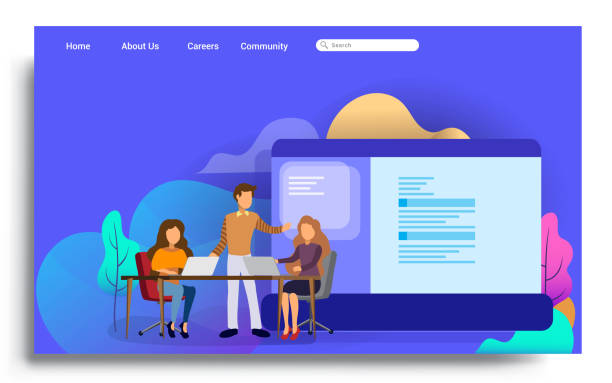The Importance of Secure Website Design in Today’s World

In the current era, where digital life has become an inseparable part of our daily activities, the topic of #web_security and #data_privacy holds special importance.
Every day, we witness numerous reports about data breaches, user information theft, and cyberattacks on various websites.
These incidents not only incur significant financial losses but can also severely damage #user_trust and destroy a business’s reputation.
Consequently, secure website design is no longer a luxury option, but an undeniable necessity for every business and individual intending to have an online presence.
A secure website means protecting sensitive user data, financial transactions, and confidential business information.
This security not only encompasses technical layers but also legal and ethical dimensions, requiring a comprehensive and continuous approach.
A complete understanding of this topic and the application of correct strategies in the process of secure website design lay the foundation for a successful and sustainable online presence.
This section is primarily explanatory and educational, aiming to familiarize readers with the importance of the topic and understand the necessity of building a secure website.
Do you dream of a thriving online store but don’t know where to start?
Rasaweb is your comprehensive solution for e-commerce website design.
✅ Attractive and user-friendly design
✅ Increased sales and revenue⚡ Get free consultation
Identifying the Most Common Website Security Threats

Before we can effectively address secure website design, it is necessary to become familiar with the most common #cyberattacks and #vulnerabilities that threaten websites.
One of the most common attacks is #SQL_injection, where an attacker injects malicious SQL code into the database via website input fields, gaining access to sensitive information.
XSS (Cross-Site Scripting) attacks also allow attackers to execute malicious JavaScript code in the victim’s browser, which can lead to the theft of cookies, session information, and even website content alteration.
CSRF (Cross-Site Request Forgery) attacks enable an attacker to perform unwanted actions on behalf of authenticated users.
DDoS (Distributed Denial of Service) attacks overwhelm the website’s server with immense traffic, rendering it inaccessible.
Finally, Brute Force attacks, which aim to discover passwords by repeatedly trying different combinations, remain a serious threat.
Identifying and understanding the depth of these threats is the first step towards adopting appropriate security measures and developing a #secure_web_system.
This section is analytical and specialized in content and addresses the identification of potential weaknesses in the secure web development process.
Principles of Client-Side Security in Secure Website Design

Website security is not limited to the server-side; #frontend_security or client-side security also plays a vital role in secure website design.
One of the most important measures in this regard is preventing XSS attacks, which primarily occur through user inputs and their insecure display.
Input Validation on both server-side and client-side (although client-side validation primarily serves user experience, and core security must be handled server-side), as well as Output Sanitization before displaying them on the web page, are fundamental principles.
Using Content Security Policy (CSP) provides an additional security layer that allows the browser to restrict permitted resources (such as scripts, stylesheets, and images) that can be loaded by the page.
Also, cautious use of DOM and JavaScript, especially when manipulating content or loading external resources, is essential.
Developers should always be aware of the latest vulnerabilities in JavaScript libraries and frameworks and keep them updated.
These measures not only offer a better user experience but also significantly reduce the risk of client-side attacks and are considered an important part of #expert guidance in secure website design.
| Validation Method | Description | Application Example |
|---|---|---|
| Length Validation | Ensuring minimum and maximum input length. | Username (min 3, max 20 characters) |
| Data Type Validation | Checking if the input matches the expected data type (number, string, email). | Age field (integers only), Email field (email format) |
| Format Validation (Regex) | Using regular expressions to check for specific input patterns. | Phone number, Postal code |
| Input Sanitization | Removing or escaping special characters that could be interpreted as malicious code. | HTML tags from user text inputs |
Key Solutions for Server-Side and Database Security

After addressing client-side security, it’s time for the core of secure website design: server-side and database security.
#Secure_server_configuration is the first step.
This includes restricting access, disabling unnecessary services, and using robust firewalls.
All operating system and server software updates must be performed regularly to prevent known vulnerabilities.
In the discussion of #database_security, using Parameterized Queries or Prepared Statements is essential to prevent SQL Injection attacks.
These methods ensure that user inputs are interpreted as data, not executable code.
Applying strong database access control policies and using encryption for sensitive stored data provide additional security layers.
API (Application Programming Interface) security, which deals with communication between different parts of a website or with external services, is also very important.
Strong authentication and Rate Limiting for APIs are among the key measures.
Finally, regular and encrypted backups of the database and server files are an integral part of #backend_security and a secure website design strategy.
This section provides specialized guidance for implementing secure web infrastructures.
Does your current e-commerce website design not generate the expected sales for you?
Rasaweb specializes in professional e-commerce website design!
✅ An attractive and user-friendly website with the goal of increasing sales
✅ High speed and security for an ideal shopping experience⚡ Get a free online store design consultation with Rasaweb!
The Role of SSL/TLS Certificates in Enhancing Website Security

One of the most fundamental aspects of secure website design and building user trust is the use of #SSL/TLS_certificates.
These certificates enable the #HTTPS protocol, which ensures that all data exchanged between the user’s browser and the website is encrypted and secure.
Without HTTPS, sensitive information such as passwords, credit card details, and users’ personal data are vulnerable to eavesdropping and tampering.
When a website uses HTTPS, its address starts with “https://” and a green padlock icon is displayed in the browser’s address bar, indicating a secure connection.
This visual trust is very important for users and assures them that their information is safe.
In addition to security, HTTPS is also an important factor in #SEO, and search engines like Google rank websites with HTTPS higher.
There are different types of SSL/TLS certificates, from DV (Domain Validated) certificates that only validate the domain, to EV (Extended Validation) which offer the highest level of authentication.
The choice of certificate type depends on the type of website and the sensitivity of its data.
Investing in a valid SSL/TLS certificate is a crucial step towards secure web development and ensuring data security.
This section is primarily explanatory and specialized.
Implementing Powerful Authentication and Authorization Mechanisms

In any web system that requires user identification, #authentication and #authorization are fundamental pillars of #web_security and play an essential role in secure website design.
Authentication is the process of verifying a user’s identity, while authorization determines what resources the user can access after authentication.
Using #strong_and_unique_passwords is the first line of defense.
Users should be encouraged to use complex passwords, and the website should ensure password hashing and salting before storing them in the database.
Multi-Factor Authentication (MFA), such as sending a code to a mobile phone or email, provides an additional security layer, making attacker access difficult even if the password is compromised.
Secure #Session_Management is also crucial; sessions should have a limited lifespan and be properly destroyed after the user logs out.
In authorization, using #Role-Based_Access_Control (RBAC) helps websites restrict user access based on their roles (e.g., administrator, editor, regular user).
These measures not only prevent unauthorized access but also improve user experience and are considered educational and guidance points in secure website design.
The Importance of Security Audits and Continuous Updates

Even the best secure website design will be vulnerable without continuous maintenance and updates.
The cyber threat landscape is constantly changing and evolving, with new methods of penetration being discovered.
Therefore, conducting #regular_security_audits and #vulnerability_scanning is an integral part of a website’s security strategy.
These audits can include penetration testing, where authorized security professionals attempt to discover system weaknesses, or automated vulnerability scanners that regularly check code and infrastructure for known issues.
#Patch_Management is also critically important.
All software, from the server operating system to web frameworks and third-party libraries, must be updated immediately upon the release of security updates.
Delays in applying patches can leave a website defenseless against #Zero-Day_Vulnerabilities or publicly disclosed vulnerabilities.
This continuous process of ensuring website security requires a news-based and specialized approach to always stay informed about the latest threats and solutions and make building a secure website an ongoing process.
| Tool Name | Tool Type | Primary Use |
|---|---|---|
| Nessus | Vulnerability Scanner | Identifying vulnerabilities in networks, servers, and web applications |
| Burp Suite | Web Penetration Testing | Intercepting, analyzing, and manipulating HTTP traffic, automated vulnerability scanning |
| OWASP ZAP | Web Application Vulnerability Scanner (Open Source) | Finding vulnerabilities such as SQL Injection and XSS |
| Metasploit | Penetration Testing Framework | Developing and executing exploits on vulnerable systems |
Planning for Security Incidents and Data Recovery
![]()
Despite all efforts for secure website design, the probability of a security incident is never zero.
Therefore, having a comprehensive and well-documented #Incident_Response_Plan is of paramount importance.
This plan should include stages of identification, containment, eradication, recovery, and post-incident analysis.
The security team must know exactly what actions to take and in what order in the event of an attack or data breach to minimize damage.
Regular and reliable backups of all website data and configurations are the backbone of a #Disaster_Recovery_Plan.
These backups should be encrypted and stored in separate locations (preferably off-site) and be quickly recoverable.
Periodic testing of recovery plans is essential to ensure their effectiveness in real-world scenarios.
Transparency in informing users in case of a data breach is not only a legal requirement in many regions but also helps maintain #customer_trust.
This content section is specialized and guiding, helping websites prepare for worst-case scenarios and have the ability to restore their site’s security after an incident.
Did you know a weak corporate website costs you many opportunities daily? Solve this problem forever with a professional corporate website design by Rasaweb!
✅ Create a powerful and reliable image for your brand
✅ Targeted attraction of new customers and increased sales
⚡ [Get Free Website Design Consultation]
Compliance with Privacy Laws and Regulations in Secure Website Design
![]()
Alongside technical aspects, secure website design also includes legal dimensions and compliance with #data_privacy regulations.
With increasing concerns about how personal information is collected, stored, and processed, various countries and unions have enacted stringent laws.
Among the most important are the GDPR (General Data Protection Regulation) in the European Union and CCPA (California Consumer Privacy Act) in California.
These laws define specific rights for users regarding their personal data, including the right to access, rectify, erase, and data portability.
For websites, this means full transparency in privacy policies, obtaining #explicit_user_consent for data collection, and implementing mechanisms to comply with these rights.
For e-commerce websites, adherence to standards such as PCI DSS (Payment Card Industry Data Security Standard) is essential for secure processing of credit card information.
Non-compliance with these regulations can lead to heavy fines and loss of reputation.
Therefore, every secure web developer must be familiar with these laws and consider them at all stages of secure website design and development.
This section is explanatory and specialized and focuses on raising awareness about legal responsibilities.
The Future of Secure Website Design and Forthcoming Challenges
![]()
The world of #cyber_security is constantly evolving, and the future of secure website design is no exception.
With rapid technological advancements, threats are also becoming more complex and sophisticated.
The emergence of #AI_in_Security holds great potential for faster threat detection and response, but it can also be misused to create more advanced attacks.
#Blockchain and Distributed Ledger Technologies (DLT) may also offer new solutions for secure authentication and data protection, but their large-scale implementation still faces challenges.
#IoT_Security and concerns about the privacy of connected devices add new dimensions to web security discussions.
In the long term, advancements in #quantum_cryptography may render current encryption methods obsolete, highlighting the need to develop algorithms resistant to quantum attacks.
To stay at the forefront of secure web development, #continuous_learning and #research and development in the field of security are essential.
Developers and website administrators must constantly update their knowledge and pay attention to future trends in the area of building a secure website.
This section, with an engaging and thought-provoking content approach, illustrates the future of web security and points out the challenges and opportunities ahead.
Frequently Asked Questions
| No. | Question | Answer |
|---|---|---|
| 1 | What is secure website design? | Secure website design is a process in which websites are built with security measures in mind from the initial stages of development to be protected against cyberattacks, unauthorized access, and data loss. |
| 2 | Why is secure website design important? | Website security is vital for maintaining user trust, protecting sensitive information (personal and financial), preventing damage to brand reputation, and complying with privacy and security regulations (such as GDPR). Security breaches can lead to financial and legal damages. |
| 3 | What are the most common cyberattacks a website faces? | Some of the most common attacks include SQL Injection, Cross-Site Scripting (XSS), Distributed Denial of Service (DDoS), Brute Force, and Credential Stuffing attacks. |
| 4 | What is SQL Injection and how can we prevent it? | SQL Injection is a type of attack where an attacker tries to manipulate the database or extract information by injecting malicious SQL code into site inputs. To prevent it, Prepared Statements/Parameterized Queries, ORM (Object-Relational Mapping), and strict input validation should be used. |
| 5 | What is Cross-Site Scripting (XSS)? | XSS is a type of attack where an attacker injects malicious scripts (usually JavaScript) into web pages that are executed by other users’ browsers. This can lead to the theft of cookies, session information, or alteration of the website’s appearance. |
| 6 | How can Brute Force attacks on login pages be prevented? | To prevent Brute Force attacks, CAPTCHA, limiting the number of failed login attempts (Account Lockout), Two-Factor Authentication (2FA), and using complex and long passwords should be employed. |
| 7 | What is the role of HTTPS in website security? | HTTPS uses SSL/TLS to encrypt the communication between the user’s browser and the website server. This prevents eavesdropping, tampering, or forgery of information during transmission and increases user trust. |
| 8 | What is the importance of Input Validation in security? | Input Validation is the process of checking and sanitizing data entered by the user. This prevents the injection of malicious code, XSS attacks, SQL Injection, and other vulnerabilities, ensuring that data conforms to the expected format. |
| 9 | Why is regular updating of website systems and software essential? | Regular updates of the operating system, CMS (like WordPress), plugins, themes, and libraries used address known security vulnerabilities. Hackers often exploit weaknesses in outdated software to penetrate systems. |
| 10 | What role does regular backup play in secure website design? | Regular and tested backups of website data (database and files) provide a vital layer of defense against data loss due to cyberattacks, human errors, or hardware failures. This allows for rapid website recovery in case of a disaster. |
And other services of Rasaweb advertising agency in the field of advertising
Smart Link Building: A creative platform to improve customer acquisition by optimizing key pages.
Smart UI/UX: Designed for businesses looking to increase click-through rates through marketing automation.
Smart Link Building: Designed for businesses looking for online growth through precise audience targeting.
Smart SEO: Revolutionize SEO ranking with the help of dedicated programming.
Smart Custom Software: A combination of creativity and technology to increase click-through rates by using real data.
And over hundreds of other services in the field of internet advertising, advertising consultation, and organizational solutions
Internet Advertising | Advertising Strategy | Advertorials
Resources
Best Security Practices in Web Design
Comprehensive Website Security Guide
Key Digital Security Tips
Secure Coding Principles for Websites
Are you ready to transform your business in the digital space? Rasaweb Afarin Digital Marketing Agency paves your path to success by offering innovative and comprehensive solutions, including professional SEO, strategic social media management, and responsive website design.
📍 Tehran, Mirdamad Street, next to Bank Markazi, Kazerun Jonubi Alley, Ramin Alley, No. 6

